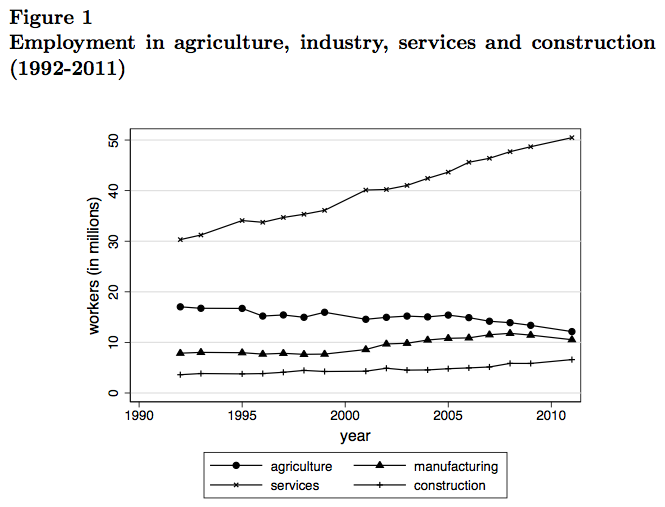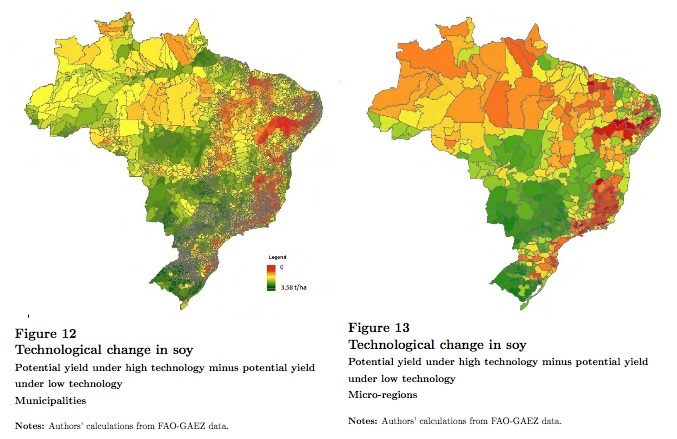Based on the experience of England during the Industrial Revolution, economists have considered agricultural productivity a precondition for economic development. The common argument is that, in order for a society to shift its efforts towards industrial production, stomachs have to be fed efficiently so that excess workforce can be dedicated to producing manufacturing goods. An increase in agricultural productivity also raises income per capita creating demand for manufacturing goods.
However, this argument hinges on the assumption that excess agricultural production is not sold to other countries at a large scale. If that is the case, an increase in agricultural productivity might attract more workers in agriculture, while manufactured goods might simply be imported. Therefore, a country that has a comparative advantage in agriculture, could actually experience a slow industrialization, a point already made by Matsuyama (1992).
So far, there is scarce empirical evidence on whether a boost in agricultural productivity might push or slow down industrial production in an open economy. In their BSE Working Paper (No. 736) “Agricultural Productivity and Structural Transformation. Evidence from Brazil,” Paula Bustos, Bruno Caprettini, and Jacopo Ponticelli show that the effect of agricultural productivity on industrialization depends crucially on the factor bias of agricultural innovation.
The theoretical mechanism in an open economy
To guide their empirical work, the authors build a simple model describing an open economy with two sectors, agriculture and industry. Agricultural production uses both land and labor, and technical progress can favor either. On the one hand, the model predicts that if the technical change is strongly labor-saving, demand for labor in agriculture falls and workers move to the manufacturing industry. The share of agriculture in employment falls and workers migrate to cities to find employment in the industry and service sectors. On the other hand, if technical change is not strongly labor-saving, then agricultural productivity reduces the size of the industrial sector.
The case of Brazilian agriculture
The Brazilian labor force has been shifting away from agriculture and increasing in manufacturing and services, as can be seen in Figure 1. At the end of the 1990s, agriculture employed around 16 million workers, while manufacturing less than 8 million. By 2011, this gap was narrowed with agriculture and manufacturing employing 12 and 10.5 million workers, respectively. During this time, land cultivated with seasonal crops, such as soy and maize, increased by 10.4 million hectares, out of which 6.2 million were converted to soy cultivation.
The model predictions are tested exploiting the adoption of two new agricultural technologies in Brazil. First, the authors analyze the adoption of genetically engineered soybean seeds. This new technology requires less labor per unit of land to yield the same output. The main advantage of genetically engineered soy seeds relative to traditional seeds is that they are herbicide resistant. Soybean production is one of the least labor-intensive agricultural activities. Second, they study the effects of the adoption of second-harvest maize. This technique allows Brazilian farmers to have two harvesting seasons in the same year, effectively increasing the land endowment.

The identification strategy
Bustos, Caprettini, and Ponticelli find that regions where the area cultivated with soy expanded experienced an increase in agricultural production per worker, a reduction in agricultural employment and an expansion in industrial employment. These effects could be due to factors other than the adoption of new agricultural technologies. For example, they could be due to a higher demand for labor in the industrial sector in these regions, leading to an increase in wages, thereby inducing agricultural producers to switch to crops requiring less workers, like soy.
In order to establish causality the authors exploit two sources of variation in the profitability of the new agricultural technology. First, they exploit time variation in the availability of these new technologies. In the case of soy, for example, genetically engineered seeds were patented in the US in 1996 and legalized in Brazil in 2003. Second, given that these new technologies had a differential impact on yields depending on soil and weather characteristics, they exploit differences in potential increase in yields across Brazilian regions.
The estimates of potential soil and maize yield across geographical areas of Brazil come from the FAO Global Agro-Ecological Zones database. These yields are calculated by incorporating local soil and weather characteristics into an agronomic model that predicts the maximum attainable yield for each crop in a given area. Additionally, the database reports estimates for potential yields under traditional versus new agricultural technologies.
The difference in the potential yield under traditional (low technology) versus new agricultural technologies (high technology) for soy is exhibited in Figure 12 (for Brazilian municipalities) and 13 (for Brazilian microregions).

In accordance with the theoretical predictions, municipalities where the new technology is predicted to have a higher effect on potential yields of soy did experience a higher increase in the area planted with genetically engineered soy. In addition, these regions experienced increases in the value of agricultural production per worker and employed fewer workers per hectare. Finally, these regions exhibit faster employment growth and lower wages in the industrial sector.
Interestingly, the effects of technology adoption are different for maize. Regions where potential maize yields are predicted to increase the most when switching from the traditional to the new technology did indeed experience a higher increase in the area planted with maize and in the value of agricultural output. Contrarily to regions where soy expanded, in regions where maize expanded more workers were employed in agriculture, while industrial employment decreased.
Agricultural productivity and industrialization: a tale of two crops
Summarizing, in line with the theoretical model, the authors find that the effect of agricultural productivity on industrialization depends on the factor bias of the new technology. When technological change in agriculture is labor saving, as in the case of genetically engineered soy, agricultural productivity favors employment growth in the industrial sector.
On the other hand, when technological change in agriculture requires more labor per unit of land, as in the case of maize, then agricultural productivity leads to a reduction in industrial employment. These different effects documented for soy and maize indicate that whether agricultural innovations favor labor or land use is a key factor in the relationship between agricultural productivity and industrial growth.




Super interesting research. Do you think this kind of studies can be applied to other Latin American countries. I assume the data constraints must be very tight, aren’t they?